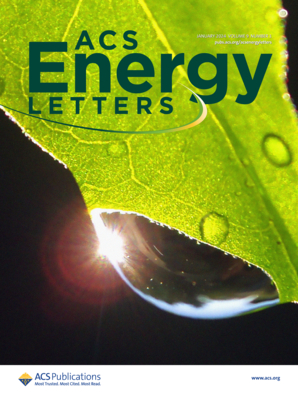先进的单离子导电嵌段共聚物电解质可实现更安全、成本更低的锂金属电池
IF 19.3
1区 材料科学
Q1 CHEMISTRY, PHYSICAL
引用次数: 0
摘要
用于锂金属电池(LMB)的高性能聚合物电解质体系通常含有相对较多的氟,以稳定电极与电解质的界面,尤其是与锂金属的界面。在此,我们报告了一种先进的单离子导电聚合物电解质,其骨架中的含氟量低于以前的系统,从而大大降低了成本,同时仍能为含有 LiNi0.6Co0.2Mn0.2O2 (NCM622) 和 LiNi0.8Co0.1Mn0.1O2 (NCM811) 正极的 LMB 电池提供高度稳定的循环。此外,我们还发现,选择 "分子传输体"(即具有高迁移率和高介电常数以促进 Li+ 传输的小分子)对于实现高性能 LMB 电池至关重要。事实上,从纯碳酸乙烯酯过渡到与碳酸丙烯酯的混合物,可以延长对氧化的电化学稳定性并提高极限电流密度,从而提高锂∥NCM 电池的速率能力和循环稳定性,并有可能在环境温度下循环使用这些电池。本文章由计算机程序翻译,如有差异,请以英文原文为准。

Advanced Single-Ion Conducting Block Copolymer Electrolyte for Safer and Less Costly Lithium–Metal Batteries
High-performance polymer electrolyte systems for lithium–metal batteries (LMBs) commonly contain a relatively high amount of fluorine to stabilize the electrode|electrolyte interfaces, particularly that with lithium metal. Herein, we report an advanced single-ion conducting polymer electrolyte that contains less fluorine in the backbone than previous systems, enabling a significant cost reduction, while still providing highly stable cycling of LMB cells containing LiNi0.6Co0.2Mn0.2O2 (NCM622) and LiNi0.8Co0.1Mn0.1O2 (NCM811) positive electrodes. Moreover, we show that the choice of the incorporated “molecular transporters”, i.e., small molecules with high mobility and a high dielectric constant to facilitate the Li+ transport, is essential for achieving high-performance LMB cells. In fact, the transition from pure ethylene carbonate to a mixture with propylene carbonate allows for an extended electrochemical stability toward oxidation and higher limiting current density, resulting in enhanced rate capability and cycling stability of Li∥NCM cells─and the possibility to cycle these cells also at ambient temperature.
求助全文
通过发布文献求助,成功后即可免费获取论文全文。
去求助
来源期刊

ACS Energy Letters
Energy-Renewable Energy, Sustainability and the Environment
CiteScore
31.20
自引率
5.00%
发文量
469
审稿时长
1 months
期刊介绍:
ACS Energy Letters is a monthly journal that publishes papers reporting new scientific advances in energy research. The journal focuses on topics that are of interest to scientists working in the fundamental and applied sciences. Rapid publication is a central criterion for acceptance, and the journal is known for its quick publication times, with an average of 4-6 weeks from submission to web publication in As Soon As Publishable format.
ACS Energy Letters is ranked as the number one journal in the Web of Science Electrochemistry category. It also ranks within the top 10 journals for Physical Chemistry, Energy & Fuels, and Nanoscience & Nanotechnology.
The journal offers several types of articles, including Letters, Energy Express, Perspectives, Reviews, Editorials, Viewpoints and Energy Focus. Additionally, authors have the option to submit videos that summarize or support the information presented in a Perspective or Review article, which can be highlighted on the journal's website. ACS Energy Letters is abstracted and indexed in Chemical Abstracts Service/SciFinder, EBSCO-summon, PubMed, Web of Science, Scopus and Portico.
 求助内容:
求助内容: 应助结果提醒方式:
应助结果提醒方式:


